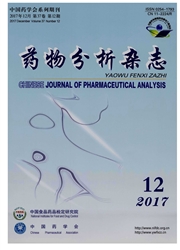

 中文摘要:
中文摘要:
目的:通过研究近红外光谱(NIRS)与HPLC指纹图谱,选择一种最佳的玉米须质量控制方法。方法:以NIRS光谱判别分析法对不同产地玉米须进行定性鉴别,建立判别分析模型,然后用三重交叉验证法对该模型进行验证;并与HPLC指纹图谱方法(色谱柱为Agilent ZORBAX SB-C18,4.6 mm×250 mm,5μm;检测波长为273 nm,柱温30℃,进样量为10μL,流速为0.8 mL·min^-1,以甲醇-0.2%磷酸为流动相进行梯度洗脱)进行对比研究。结果:NIRS判别分析模型将2个产地的玉米须清晰地聚为两类,界限明显;而HPLC指纹图谱相似度分析结果发现:同一产地的样品相似度较高但并未均达到0.9,而不同产地的玉米须样品的相似度并无明显差异;因此,NIRS判别分析结果优于HPLC指纹图谱试验结果,且分析过程简便、快速。结论:利用NIRS光谱判别分析的优点,能够快速、准确地分析玉米须的质量,可以作为玉米须的一种质控方法。
 英文摘要:
英文摘要:
Objective: To study the two techniques of NIRS and HPLC fingerprinting, so as to select the best method for quality control of Corn Stigma. Methods: The NIRS discriminant analysis method was carried out to establish discriminant analysis model for the qualitative identification of Corn Stigma from different areas, and then the model was validated by three fold cross validation method and compared with the HPLC fingerprint method the HPLC fingerprint method ( Chromatographic column is Agilent ZORBAX SB-C18, 4.6 mm × 250 mm, 5 μm; the detection wavelength is 273 nm, the column temperature is 30 ℃ ,the sample size is 10 μL, the flow rate is 0.8 mL·min^-1, and the methanol -0.2% phosphoric acid is the mobile phase to elute gradiently ). Results: Two samples frome two origins samples were divided into two parts by the model of NIRS qualitative discriminant analysis, and there was a clear distinction between different regions. However, the similarity analysis of HPLC fingerprints showed that the similarity of samples of the same area was higher but did not reach 0.9, and the difference of the samples from different areas was not significant; NIRS spectral discriminant was better than the experimental result of HPLC fingerprinting. Compared with HPLC fingerprint, the analysis process of NIRS was simpler and faster. Conclusion: By taking the advantages of NIRS, it can be used to analyze the quality of the Corn Stigma quickly and accurately, which can be used as a quality control method.
 同期刊论文项目
同期刊论文项目
 同项目期刊论文
同项目期刊论文
 期刊信息
期刊信息
